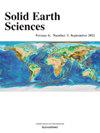喀麦隆Douala次盆地中albian -下Turonian沉积物的物源、成岩作用和古气候:沉积学、矿物学和岩石学方法
IF 2
4区 地球科学
Q3 GEOSCIENCES, MULTIDISCIPLINARY
引用次数: 0
摘要
在几内亚湾中心的Douala次盆地北部的四个地点,研究了Albian -下Turonian沉积物的沉积学、矿物学和岩石学组成,以确定它们的来源、古气候和38个样品的成岩作用。确定了几种岩性,从粘土/页岩到粉质粘土,较差胶结的细粒砂岩到粗粒砂岩,砾岩到砾岩砂岩。蒙哥河东部为连续的正层序,西部为旋回沉积。砂岩主要为粗砂砂岩、次粗砂砂岩、次粗砂砂岩、次粗砂砂岩和罕见的岩屑砂砂岩和粗砂砂岩,它们来自泛非造山运动时期形成的新元古代基底。电气石、蓝晶石、硅线石等重质矿物的存在表明矿床来源于深部和变质岩。这些最新沉积物的稀有性表明,强烈的化学风化作用已经影响了烃源岩。这些矿床主要位于近端。此外,多晶石英具有波动消光,单晶石英具有非波动消光,表明其来源是混合的。锆石颗粒的棱柱形、次棱柱形和次棱柱形等多种微观结构和形态进一步支持了混合物源。棱柱形和非波动型单晶石英颗粒占主导地位,表明成矿物质以深成岩为主。x射线衍射分析表明,高岭石是粘土相中主要的粘土矿物,但高岭石含量偏少,表明阿尔—塞诺曼期气候较为湿润,塞诺曼期气候较为湿润。物性蚀变作用是影响矿床发育的主要因素。本文章由计算机程序翻译,如有差异,请以英文原文为准。
Provenance, diagenesis, and paleoclimate of Albian-Lower Turonian deposits in the Douala sub-basin, Cameroon: Sedimentological, mineralogical, and petrographical approaches
The sedimentological, mineralogical, and petrographic compositions of the Albian - Lower Turonian deposits at four sites in the northern part of the Douala sub-basin located in the heart of the Guinea Gulf were investigated to determine their provenance, paleoclimate, and diagenetic effects from thirty-eight (38) samples. Several lithologies are identified, ranging from clays/shales to silty clays, poor consolidated fine-to coarse-grained sandstones, and conglomerates to conglomeratic sandstones. The deposits are made up of successive positive sequences in the eastern part of the Mungo River and cyclic deposits in the western part. The sandstones are primarily arkose wacke, secondarily arkose, subarkose, sublith-arenite, and rare lithic arenite and wacke derived from the Neoproterozoic basement formed during the Pan-African orogenesis. The presence of heavy minerals such as tourmaline, kyanite and sillimanite indicates that the deposits originate from plutonic and metamorphic sources. The rarity of these latest in the sediments suggest the intense chemical weathering that has affected the source rocks. These deposits are mainly proximal. Additionally, the association of polycrystalline quartz with undulatory extinction and monocrystalline quartz with non-undulatory extinction suggests a mixed source. The various microstructures and morphologies of zircon grains including prismatic, sub-angular and sub-prismatic shapes further support a mixed provenance. The dominance of prismatic shape and non-undulatory monocrystalline quartz grains indicates a predominance of plutonic sources. X-ray diffraction analysis revealed that kaolinite is the dominant clay mineral found in clayey facies, though its moderate to low quantity indicates a more humid climate during the Albian-Cenomanian and a less humid climate during the Cenomanian. Physical alteration processes have mainly affected the studied deposits.
求助全文
通过发布文献求助,成功后即可免费获取论文全文。
去求助
来源期刊

Solid Earth Sciences
GEOSCIENCES, MULTIDISCIPLINARY-
CiteScore
3.60
自引率
5.00%
发文量
20
审稿时长
103 days
 求助内容:
求助内容: 应助结果提醒方式:
应助结果提醒方式:


